These thoughts were penned while riding a Surly Pugsley from Patagonia to Cuzco, Peru – it’s only now that I’ve got round to posting them. During this last trip in Ecuador I’ve been aboard a Surly Krampus. Thoughts on the relative merits of fatbikes v 29+ are in the pipeline…
First things first. I should point out that I didn’t set out to tour on a fatbike. The opportunity arose – in that I bought/swapped/borrowed/stole the Surly Pugsley my friend Daniel had painstakingly built to ride the Carretera Austral, sending back my Ogre in exchange. Having hung out with Joe, Nicolas and Kurt, I’d long thirsted to try out a monster-tyred bike, and seeing his in action on the deep gravel and washboard roads of Patagonia merely served to seal my fat biking fate.
Because of this impromptu decision, the bike isn’t built up exactly how I’d have done it myself – but it’s close enough. Also, the thoughts below are based on the experience of riding the Pugsley as a touring bike, rather than any investigation into its character come the midst of an Alaskan winter, or as a mountain bike. Certainly, I’ve spent more time than I’d have liked pushing its gargantuan wheels across windswept, Patagonian paving. After all, despite my steadfast aspirations to ride dirt roads whenever I can, the reality of a long distance, cross continental tour means that long stretches of pavement are inevitable, particularly when crossing the likes of the Argentinian pampa.
And with ten thousand kilometres or so to my name since we made the swap, I can certainly vouch that the long slogs have been… long. I won’t deny that at such times, my mind hasn’t obsessed over the merits of skinnier and lighter tyres: a Pugsley is not a bike to tour on if you’re motivated most by efficiency or speed. For the most part, I’d say it makes you work harder. But crossing these vast expanses has also proved eminently do-able. After all, a bike is a bike, and generally speaking, there are more similarities than differences. Pumped up to a mighty (by fat bike standards) 20psi, Knards roll surprisingly well on pavement, even if it sounds like you’re carrying a beehive in your bags.
But it’s not until pavement gives way to dirt that the penance of carrying such heavy rubber really pays dividends. This is where I’m going to wax lyrical. On rocky climbs, grip is nothing short of phenomenal, as it is on baby-head strewen descents. There’s a sure-footedness that feels incredibly confidence inspiring, let alone smile inducing. Over corrugated ripio – the roughcut gravel roads typical to Patagonia – the Pugsley is simply in a league of its own. Even when conditions are at their most jarring, the ride quality feels never less than tolerable. On anything else it’s velvety, perhaps better even than suspension at smoothing out the likes of Ecuadorian cobblestones. I’m sure it’s largely due to this that I never suffered from backache, even after days of bodily abuse.
Then, there’s the backcounty of the Bolivian altiplano… a land of endless corrugation and sand. I can’t imagine a better bike for such a journey, and I doubt I’d have enjoyed myself half as much on any other set of wheels, bar perhaps the likes of a mid-fat, like 29+. All the other tourer I met were aboard relatively skinny-tyred traditional tourers, and whilst there’s no denying they were still out there, doing it, smiles were certainly in short supply. Later, Mike and I tackled a 200km stretch of train line running through Peru. Again, it was not just eminently rideable, even directly over railway sleepers, but incredibly fun too. More saliently, I’m not sure the notion of tackling such a route would have even entered my imagination otherwise. The bottom line? Fatbikes are the perfect excuse to take the road less travelled. And when there’s no road left, to keep riding.
Indeed, it’s when you leave such limitations behind that the world begins to really open up, exponentially. Beaches become both traversable and incredibly enjoyable. Tyres leave barely a trace in sand. In Patagonia, the Pugsley trounced across a coastal stretch of pebble and stones with panache. Before long, I found myself pouring over satellite imagery on Google Earth, and weaving all manner of terrain into the patchwork of my tour. Stretches of road that may previously have conjured dread could now be tackled with relish. How much of this kind of terrain you aspire to ride, and whether the idea fills you with wanderlust, may well help decide whether you’ll love touring on a fatbike or not.

Beach cruising in Ushuaia. Become friends with Google Earth and discover a whole new world of touring.
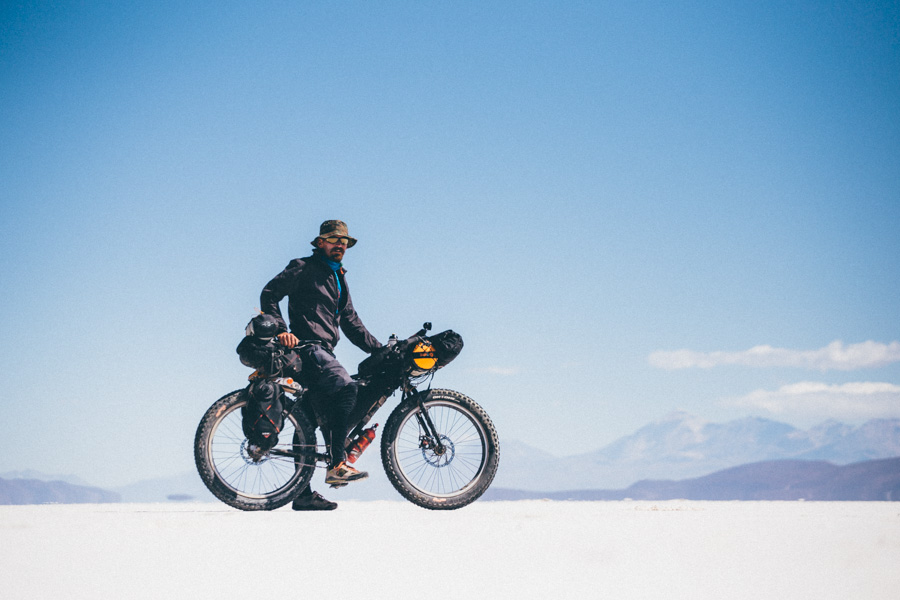
Andi and his Pugs on the Salar de Ayuni.
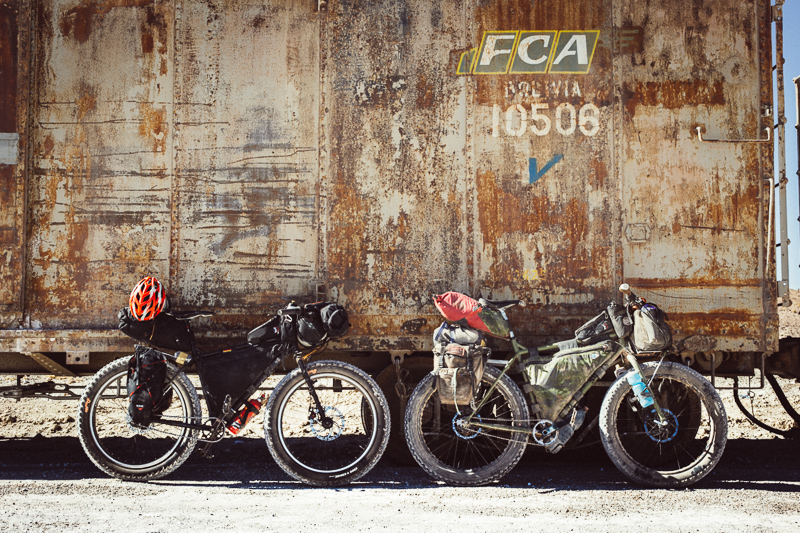
Mad Max Pugs. No featherweights for sure, but they’ll handle anything you care to throw at them, apocalypse or not.
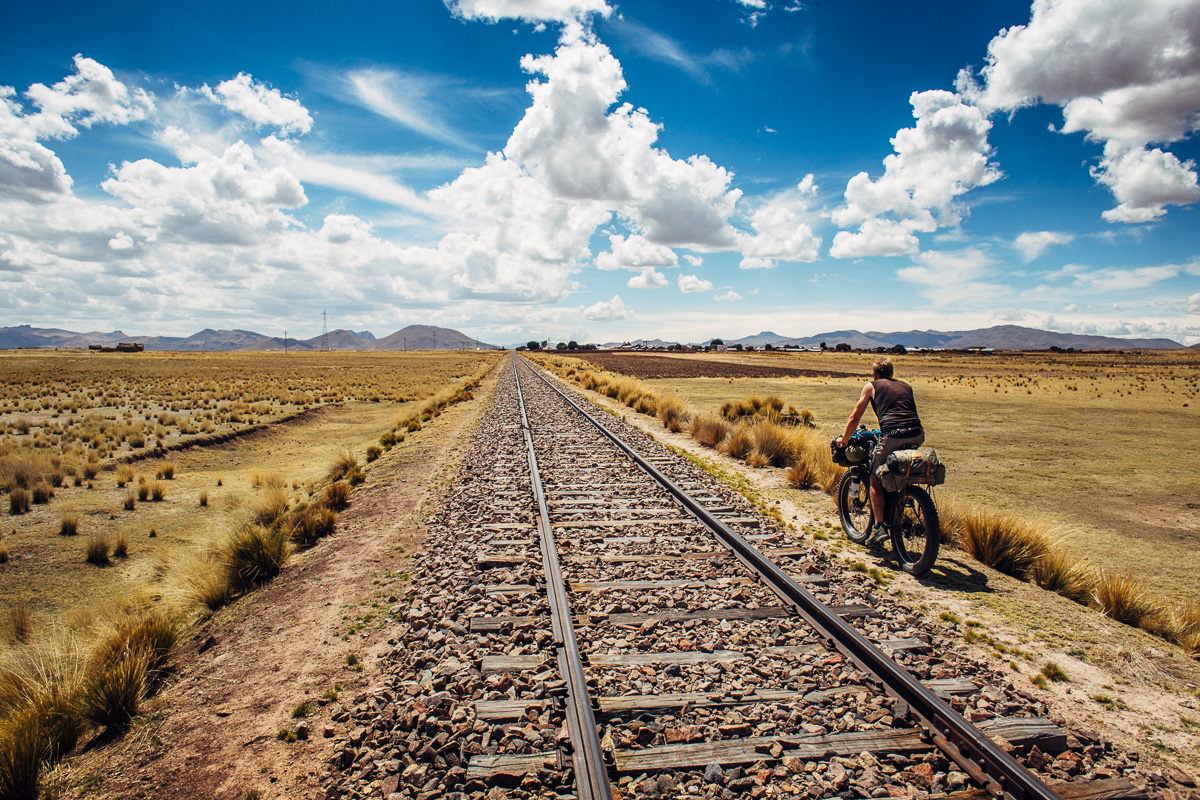
Mike riding the Cusquenan rail trail, Peru, on the Pugsley he bought from Andi. Like me, he sent his Ogre back in exchange. On several occasions, we rode right through the middle of the rails, bouncing along the sleepers. I’m not sure I’d want to do this on any other touring bike.
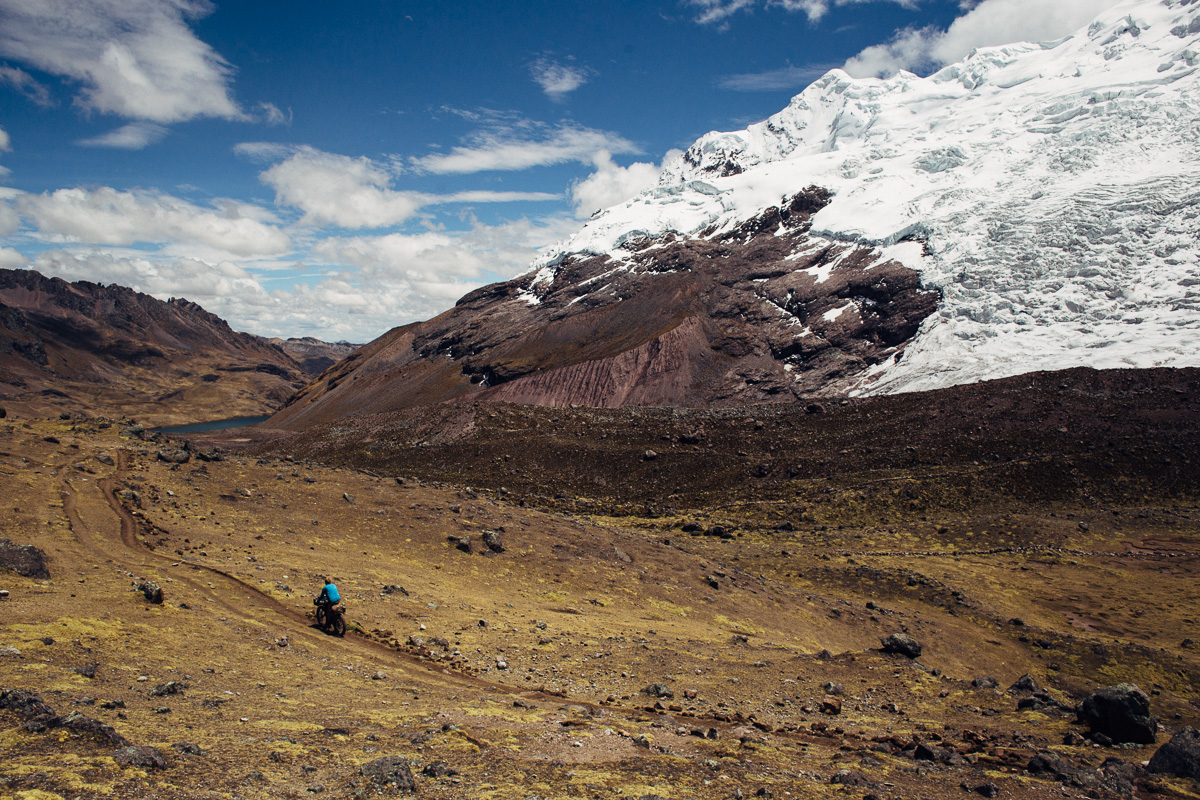
A fatbike’s lethargy on pavement is more than made up for by the off-grid scope it both offers and encourages. Who wants to tour amongst traffic, anyway?

It’s not so much that you couldn’t ride these sandy, corrugated Bolivian roads on any other bike. It just wouldn’t be as much fun. And that’s not a word you often hear associated with long distance touring bikes.
Under pressure
I find myself adjusting the tyre pressures on my Pugsley considerably more than I have on any other bike I’ve owned. Tyre pressure is surely the fat biker’s obsession. Just a psi or two makes can make a noticeable difference. Too low, and self steer becomes an issue. Too high, and the tyres bounce rather than absorb. I’d recommend a pump with a relatively large barrel for quick and easy adjustments. My lightweight Lezyne Micro Floor Drive mini floor pump (the High Volume version) has been excellent.
Tyres and Rims
Tyre wear certainly needs considering, as is the cost and ease of sourcing replacement rubber. I was fortunate enough to have had a set of folding 120 tpis sent to me by Surly – otherwise, I’d definitely stick with the more affordable 27 tpis, or other brands (Vee Rubber Missions are cheap). But if your trip is 5,000km or less, I wouldn’t worry about bringing a spare – after all, fat bike tyres are 1.2-1.6kg a piece, and take up a lot of space. And if it’s longer, I’d make use of South America’s excellent encomienda service. For a nominal fee, boxes can be shipped on by bus, and often stored in an office for up to a month.
As for rims, I wouldn’t go wider than Marge Lites or Large Marges. At 65mm, they’ll fit a 2.5in downhill tyre, which are cheap and in plentiful supply in South America, effectively meaning there’s generally a bail option relatively close to hand.
Given the recent massive fatbike explosion – almost every brand now makes a least a model – fatbike tyres may well become easier and easier to source. At the time of writing (March 2015), they’re available at Cikla in Quito (Surly Nate $90), or at their sister shop in Cuenca. And budget tyres (for as little as $30) can now be bought in Chile, via Jaime – see his Facebook page Fatbikes en Chile. Strategically speaking, this should cover you for a trans continental journey. Email ahead to check they’re in stock – most bike shops will happily send parts by bus if you can find a means to pay them.
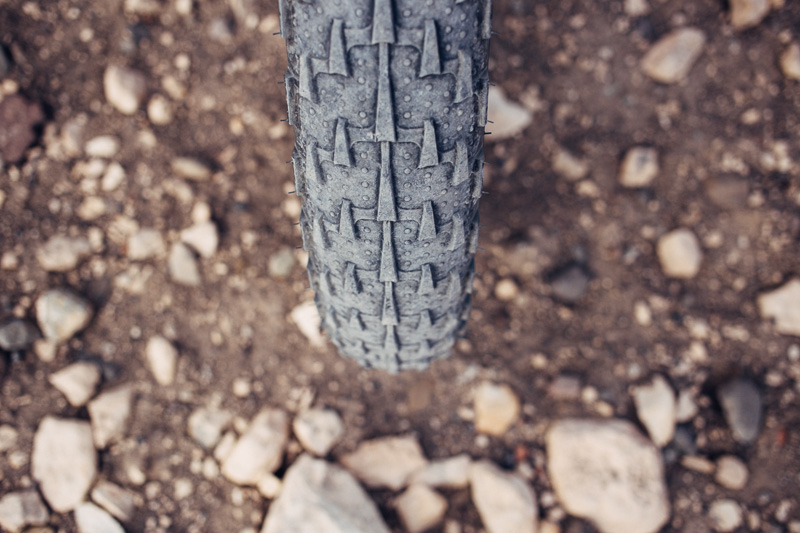
I replaced my rear 27tpi Knard with a lighter 120tpi Larry, 5500km into the trip. But forget the weight and remember that fat tyres slow you down, in a good way.
Offset frames and Rohloffs
The nature of an offset frame means running a Rohloff in a Pugsley will never make the most of one of the internal hub’s advantages – the ability to build up a strong, symmetrical wheel. Additionally, the angle of exit as the spoke leaves the rim is especially tight, thanks to the large body of the hub, which in turn can cause stress below the nipple. So make sure you do a good job building your wheel.
It’s only recently that the Rohloff XL has been announced – if I was starting afresh and hankered for a Rohloff with a non-custom fat bike frame, it would definitely be an avenue I’d explore. Or, if I had the budget, I’d be looking seriously into something like this.
Travelling light
There’s no denying the Pugsley is a hefty bike. Which makes all the more reason to pack as light as possible. Indeed, the two go hand in hand. If you aspire to tackle the kind of terrain this bike is crying out to ride, you’ll want to keep your possessions to a minimum.
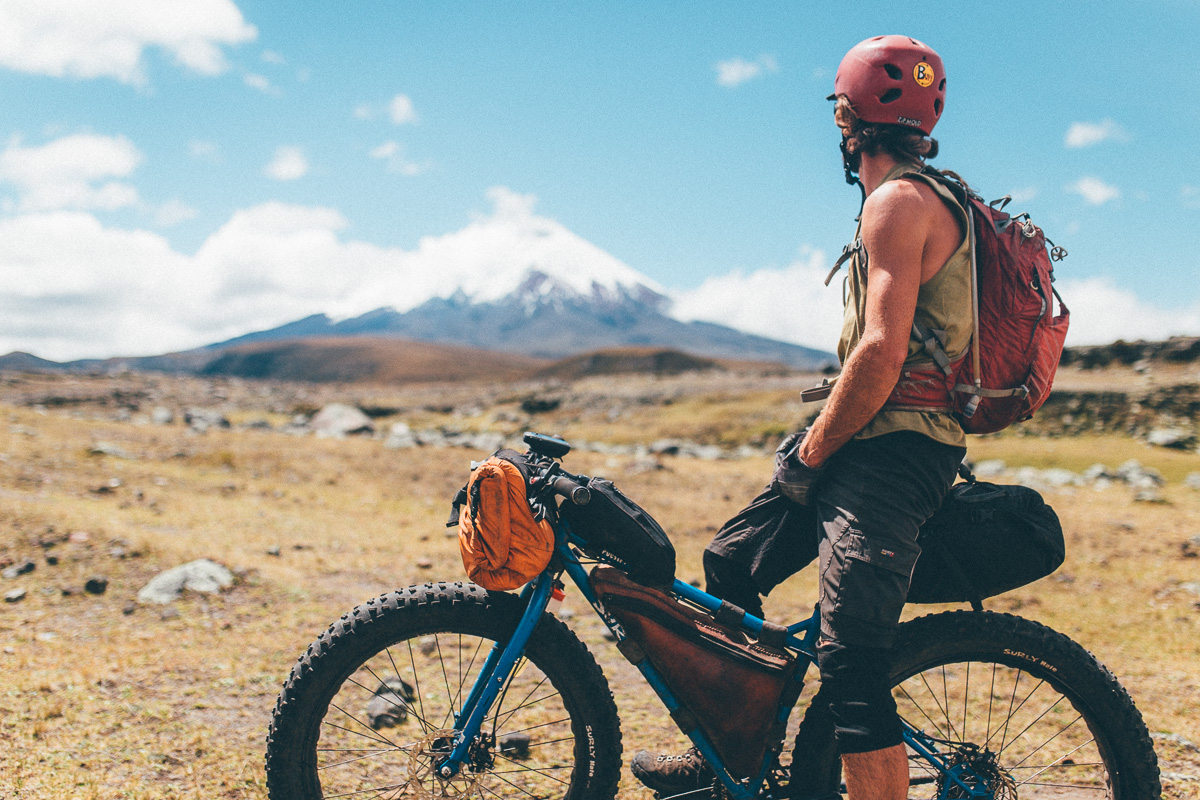
Michael Dammer travelling light on his Pugsley during our Trans Ecuador ride.
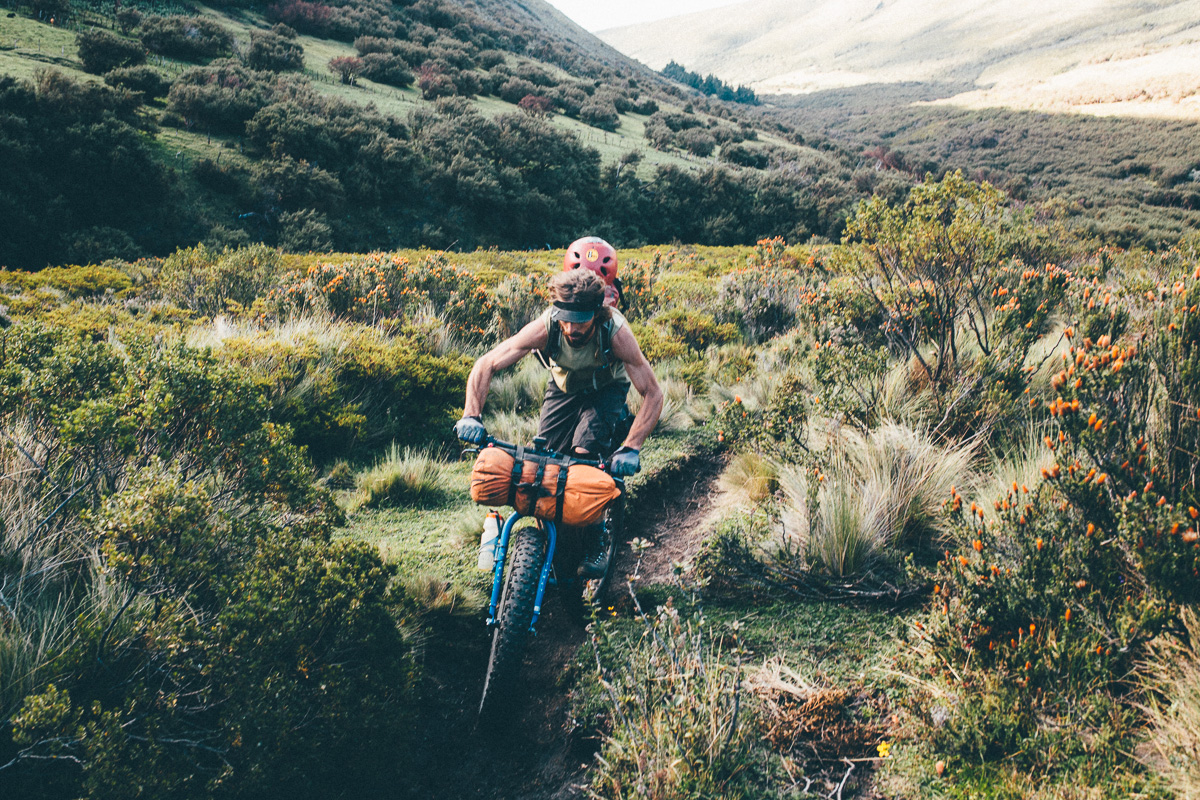
There are more trail orientated fatbikes better suited mountain biking, but the Pugsley is still a very capable all rounder.
A few niggles
Particular to an offset frame, the pads on my rear BB7 brake caliper are be hard to adjust – this is best done by feel, as you can’t see exactly how they line up. Removing the rear wheel on a Pugsley, when run with a Rohloff and a Monkey Bone, is a little more time consuming, as one caliper bolt needs to be removed, and another loosened. Even more reason for going tubeless – fat tyres can be a pain to mount. I often needed to soap the bead to ensure a straight fit. The frame has Anything Cage eyelet on the fork, and plenty of braze ons for racks. But come on Surly, where’s that water bottle mount underneath the downtube?
I’m not going to say I wish my Pugsley was lighter, because Surly frames are both affordable and extremely tough. This is a bike I’d happily load in the trunk of a South American bus. It’s a bike I’ve flown with unboxed. It’s a bike I can count on.
Instant fame
Don’t ride a fatbike if the thought of fielding a barrage of repetitive enquiries is irksome. Rather, understand that everyone will want to touch it, feel it, talk about it. Even grannies will squeeze fat tyres as they would a small child. Accept that fascination will follow you at every turn. Ride it instead because a fatbike is a great conversation starter; somehow, it even transcends cultural divides. Riding the Pugs has opened untold numbers of doors; on more than a few occasions, it’s earned me an invite to camp in a yard, or even a meal.

I constantly turned down offers to exchange my Pugsley for flocks of alpacas and llamas. And I love llamas…
Some build details:
Drivetrain: Rohloff Speedhub, Surly 36T Chainring, Rohloff 16T sprocket, Surly OD Cranks.
Wheels: Marge Lites, Son 135mm front hub and 27tpi Knards, with 8oz of Slime per tube. 180mm rotor at the back, 200m rotor at the front.
Other: AMPierce ti handlebar, XT levers, Ergon GP1 BioKork grips, Thomson seat post, Ritchey stem, WTB Pure V saddle (all time favourite), offset specific Old Man Mountain Sherpa rack (one bolt sheared), Nitto M18 front rack (perfect for supporting my Carradice saddlebag).
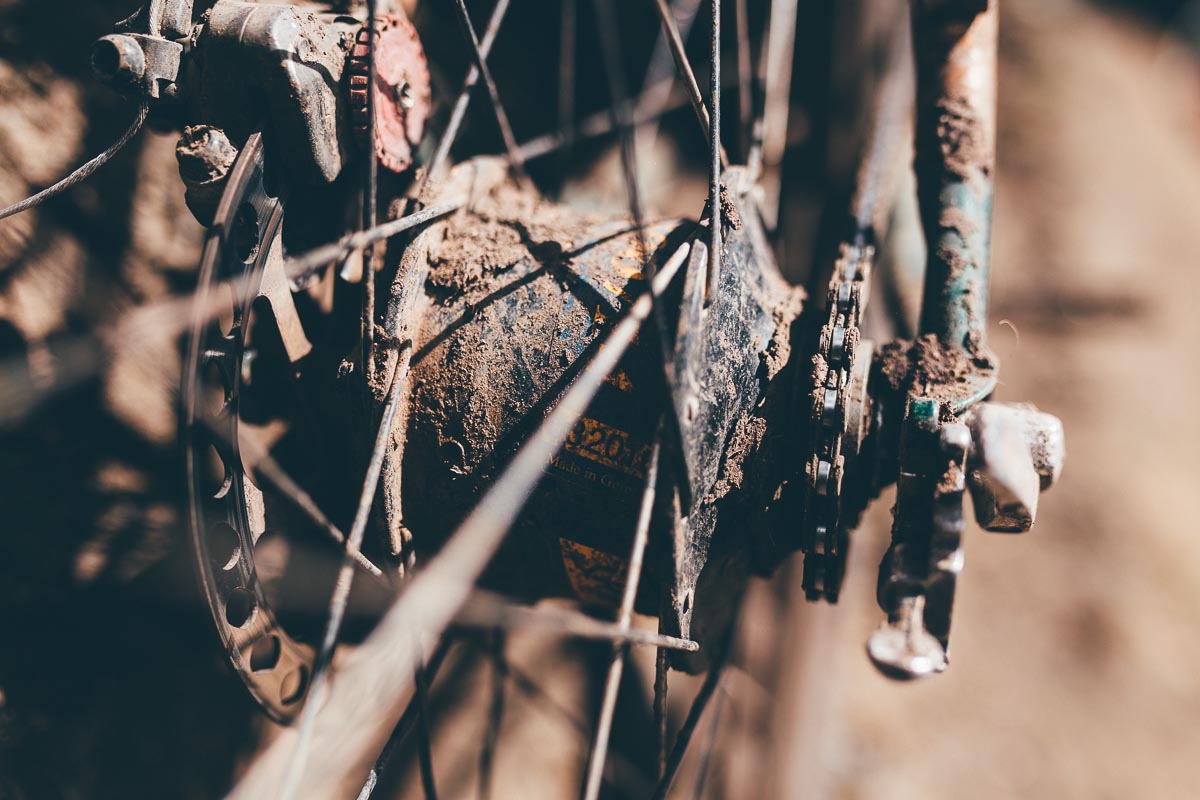
The Rohloff Speedhub is an awesome piece of kit, and makes the perfect drivetrain for fatbikes, given the kind of terrain they encourage. There’s an XL version now for symmetrical frames.
Changes I’d have made:
Setting my tyres up tubeless (which I’ve done since writing this review – ghetto style).
175mm cranks, for more ground clearance.
180mm rotors front and rear (200mm is overkill for me).
I’d probably have specced the rear wheel with a heavier Large Marge XC, for long distance touring. As it is, the Marge Lites held up absolutely fine. I guess that big tyre volume of air provides a nice cushion.
A different colour. I like Pugsley blue!
Flying with a fatbike:
I’ve only flown with the Pugsley once, back from Peru. To my surprise, my XL frame fit easily into a Specialized bike box, designed for a large, full suspension bike (I noticed they come in bigger, wider boxes than the hardtails). I just had to remove the front tyre, as well as the usual dismembering.
Other long distance fatbike tours in South America:
Aside from Joe and Kurt, who are linked above, there’s Mike Howarth, Dan and Gina and Matt Kerner. All riding Pugsleys, as it happens. Their burly frames certainly suit the vagaries of long distance travel. Within Ecuador, the Dammers gets up to all kinds of incredible páramo adventures on their Krampus and Pugsley.
Touring with mid-fat/29+:
The 29+ wheel size – effectively a wide, 29er rim, shod with 3in tyres – definitely makes a worthy alternative to full fat tyres for touring. Perhaps it’s even a more sensible all rounder for long and adventurous transcontinental trips. The tyres roll that bit faster, especially on pavement, yet still handle rough terrain with assurance and comfort, whilst offering some weight saving too. 29er tyres are becoming ever more available in South America, so emergency spares are less of an issue. I can see Surly’s ECR and Genesis’ Longitude being great steeds for backcountry travel across the continent, with the same fatbike caveats – ‘mid-fats’ are also on the heavy side, so pack light.
But I still maintain there’s distinct advantages to full fat too: incredible flotation, a far wider and cheaper tyre choice, the intrinsic strength of a 26in rim, and the option of running wide volume 26in tyres, which are easy to find, everywhere. As off-grid exploration bikes, they rule.
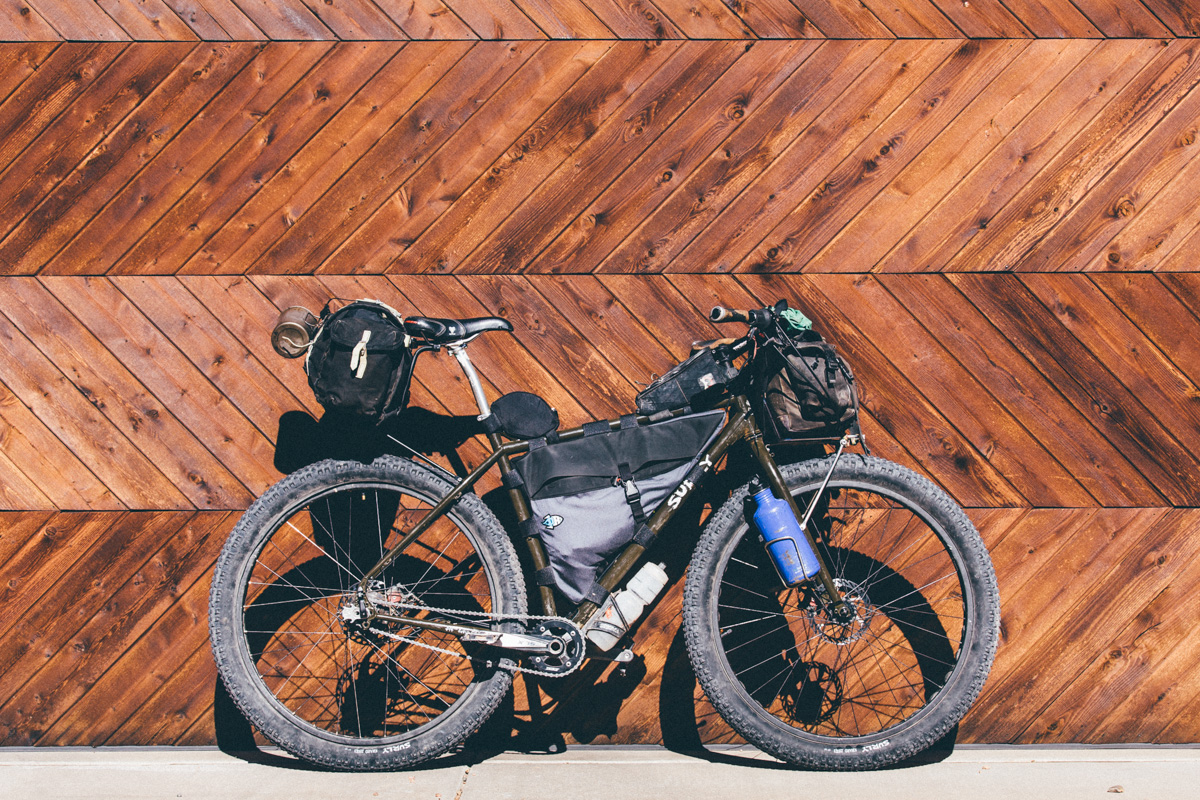
As a more limber but ethically similar relative to fatbikes, the 29+ platform is definitely worth considering too.
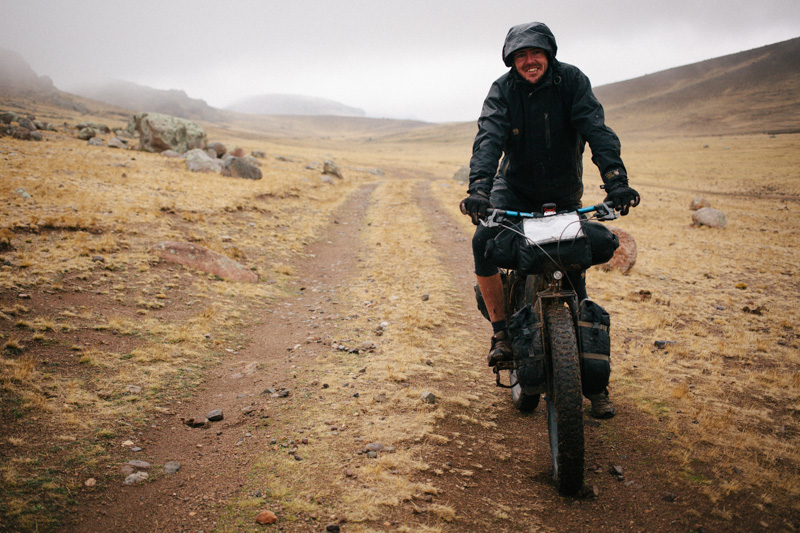
Kurt and his Pugs on the Peru Divide. See that smile?
In short:
Before leaving for this particular leg of the trip, I’d deliberated endlessly about bringing my Surly ECR (29+), but settled finally on my trusty Ogre. I’d come to the conclusion that a 2.4in tyre was the sweet spot for the kind of touring I enjoy most; the perfect balance of speed and off road prowess. Since then, I’ve evolved my view. I still think the Ogre is a supremely capable and versatile bike. But I now can’t see myself wanting to run a tyre narrower than 3in, given the places I like to ride most. Above all, I love how fat tyres shift the emphasis from speed to that of exploration.
When it boils down to it, there’s enough overlap between touring on a fat bike and a large volume 29er that both will do just fine, for the vast majority of the time. But it’s the minority of time – that small percentage where I’ve really needed a fatbike – that I remember most.
Simply put, travelling on a Pugsley has rarely failed to dish out the smiles. It’s a bike with character; one that’s easy to get attached to, foibles and all. It’s introduced me to off-grid travel, in its truest form, and opened up my mind to a more creative style of bicycle touring. I’ve begun to look at maps with new eyes, and see adventures that might otherwise have gone overlooked.
Fatbikes are dream-weavers, and above all, plain old-fashioned fun.
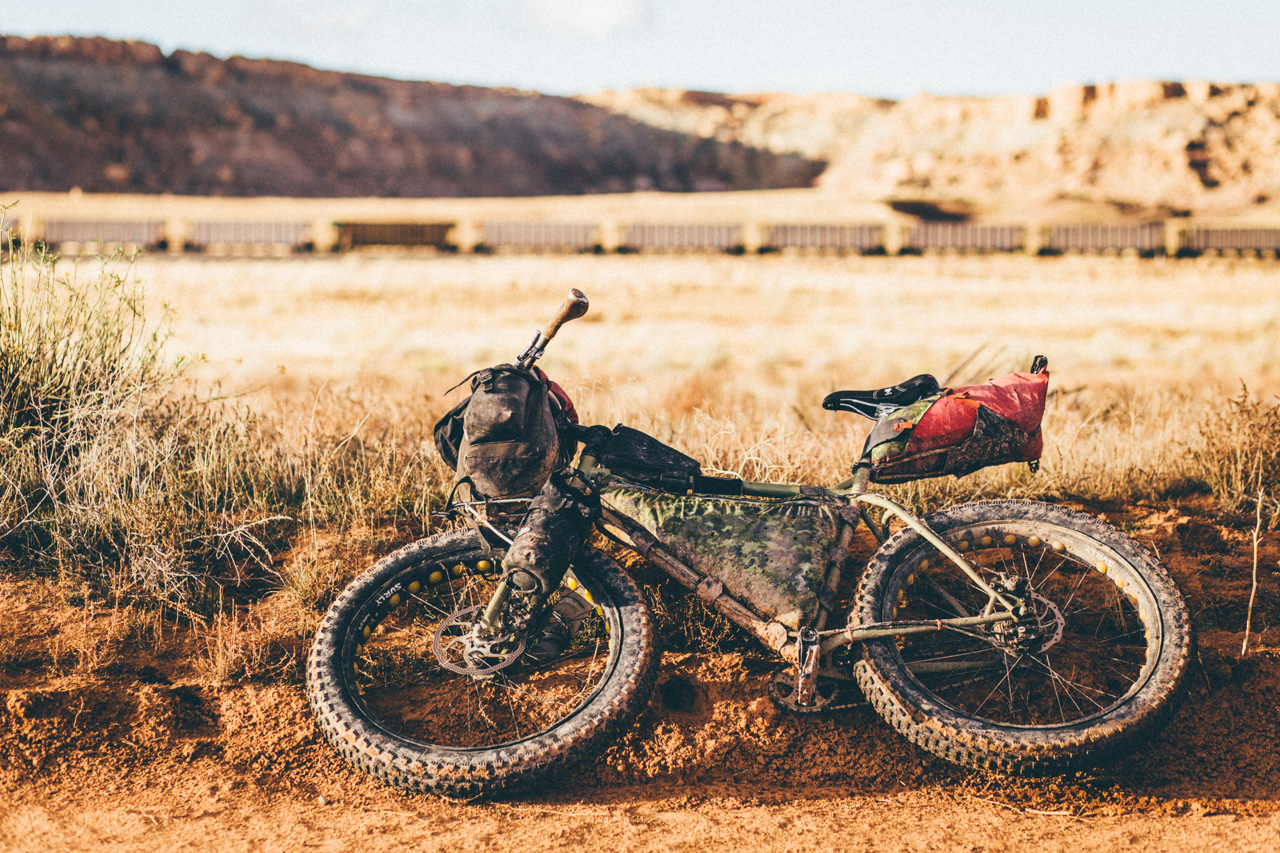
Fatbikes are machines to tour on because you see potential, rather than limitations. Travelling light is part and parcel of that.
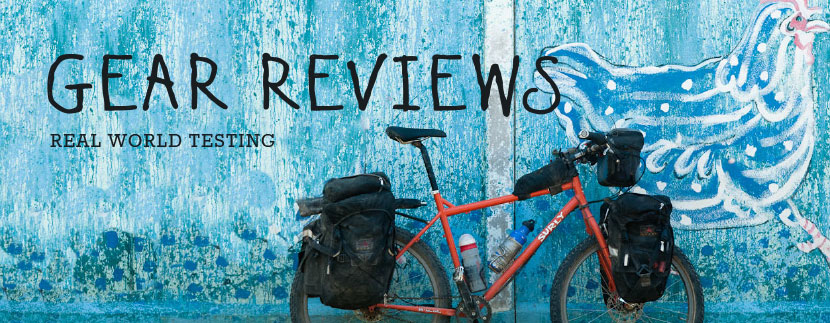

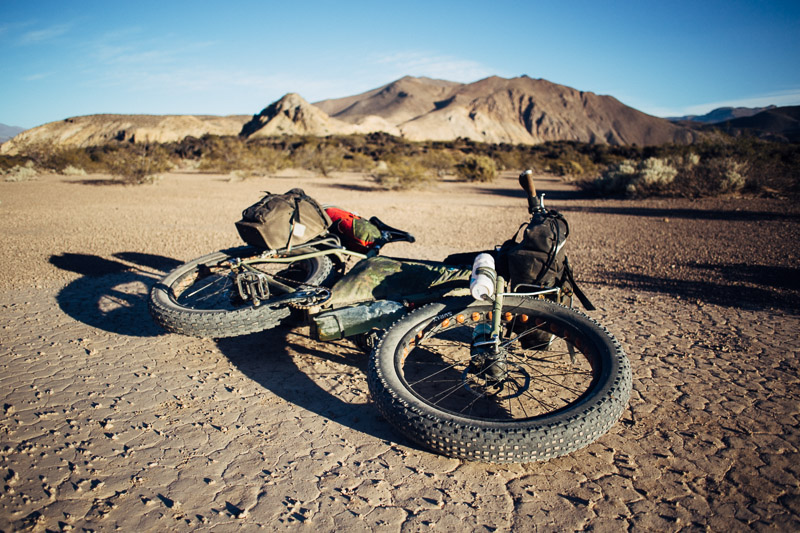
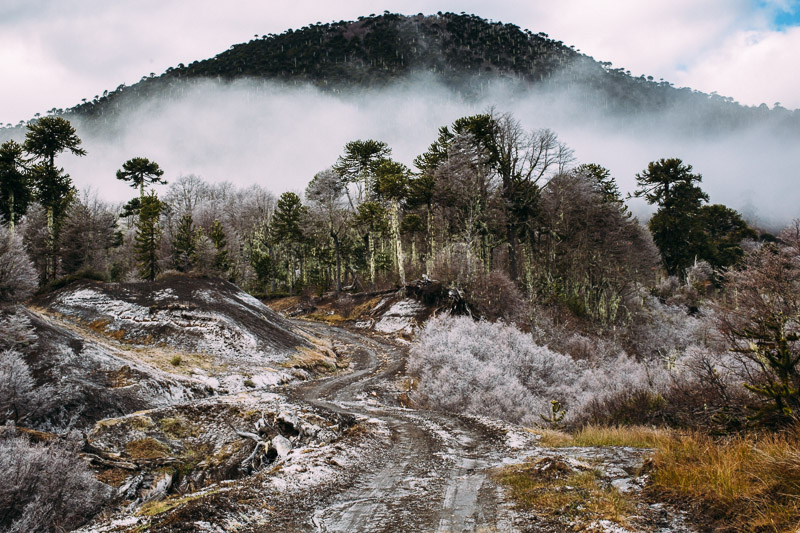





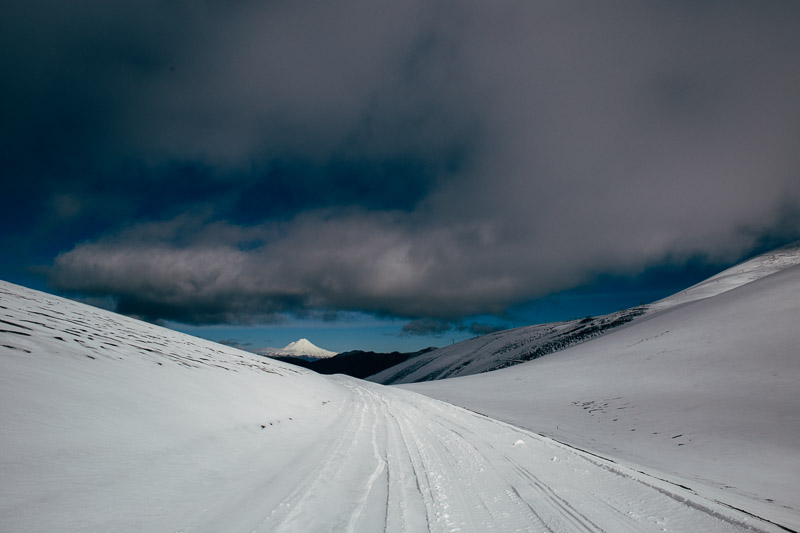
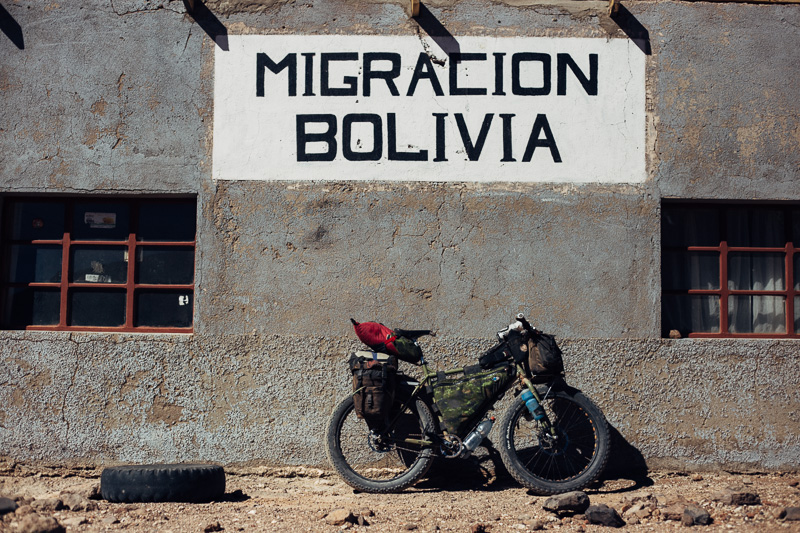
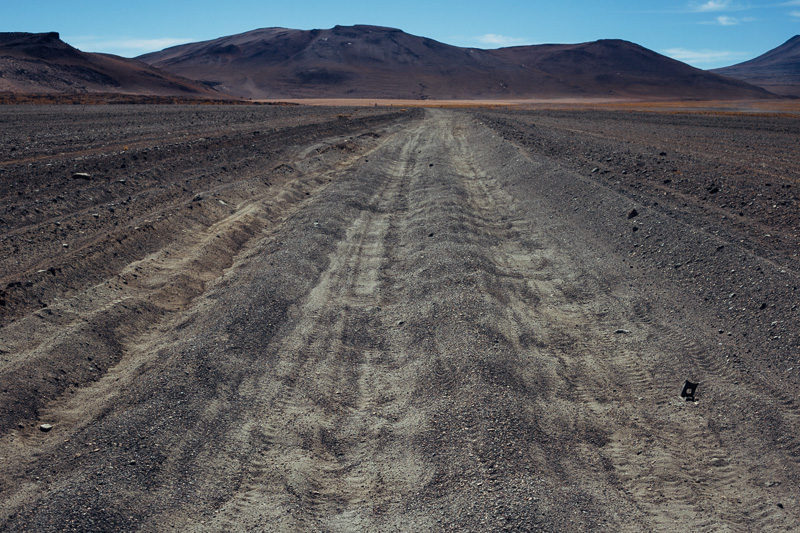
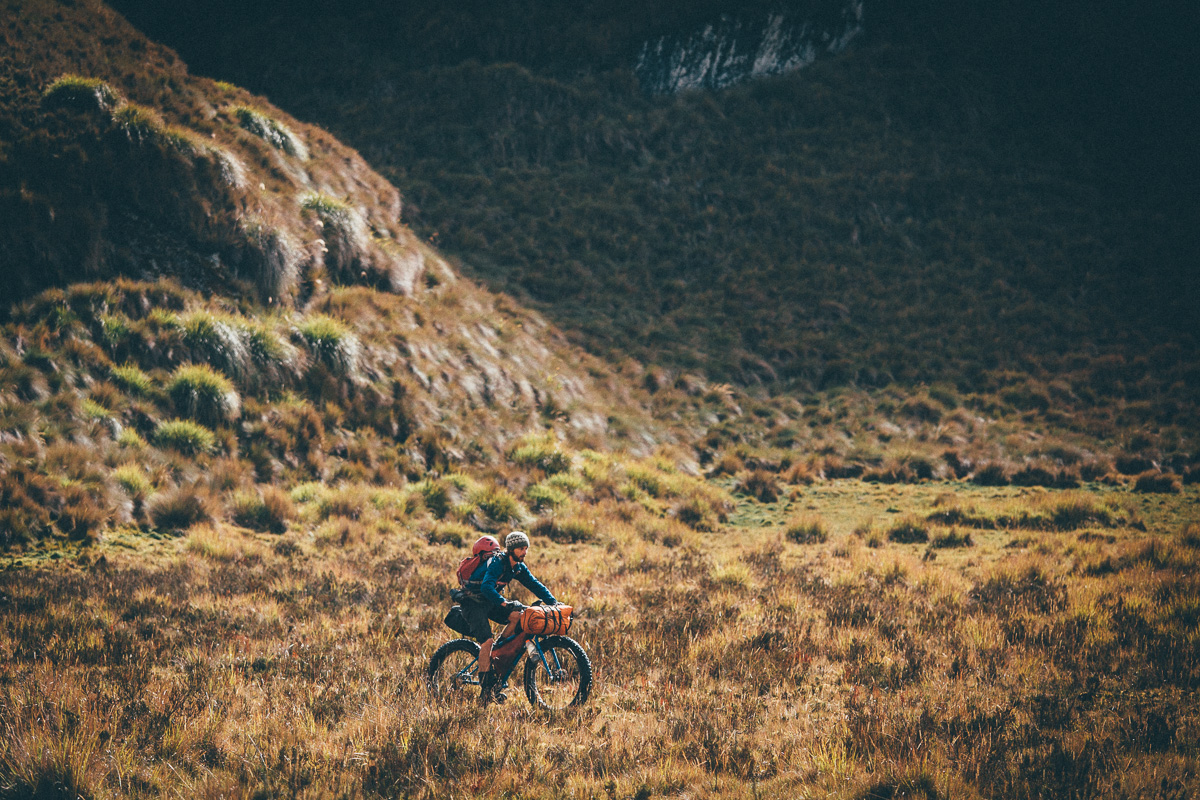


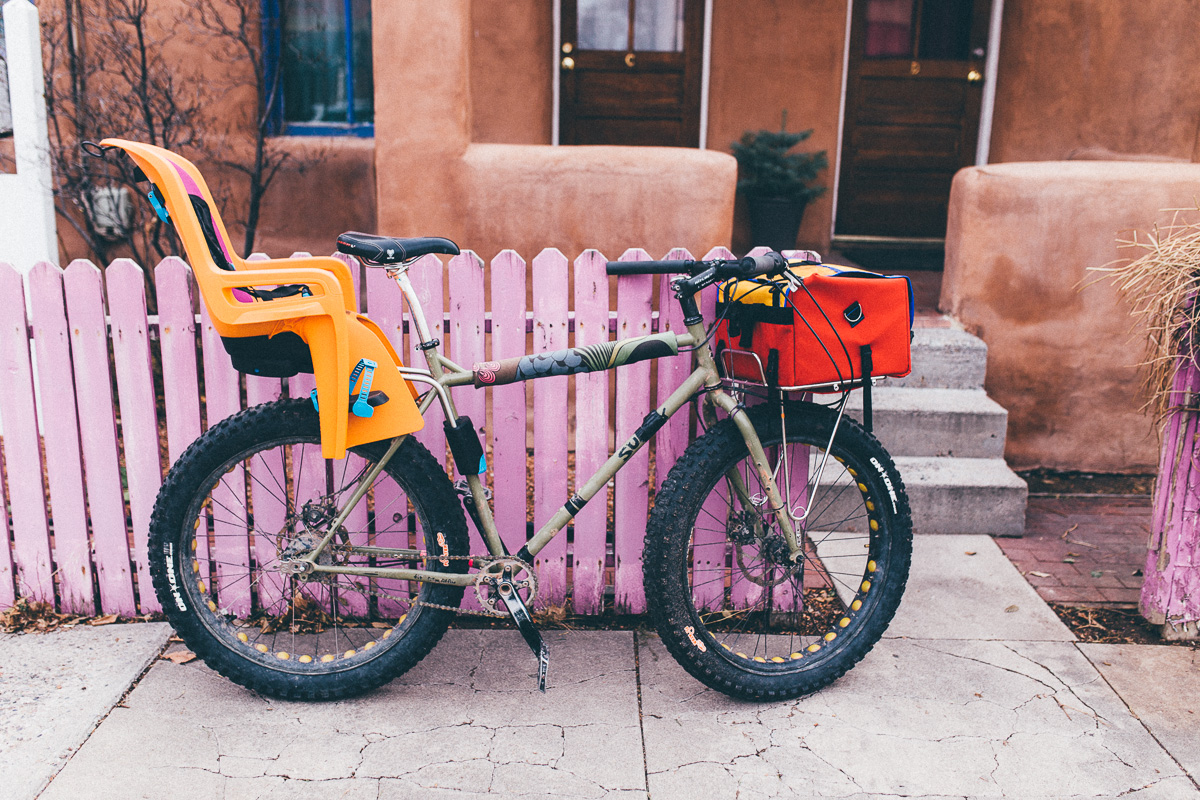

Fat tires rule! I recently got my hands on a digital pressure gauge, to see with some accuracy what pressures I’ve been running on my 29×3″ (29+) tires. Turns out I very often have been lowering my front tire to below 10PSI, and can ride with both as low as 5PSI. For most aggressive trail riding, 9 front/12 rear is best. This is really not so different from 3.7″ fat bike tires – seems like only about 10-15% less flotation compared to a typical fat bike running 65mm rims and 3.7″ tires. My conclusions was a) 29+ is a viable option for a lot of ‘fat bike terrain’, and b) I want a fat bike with 4.8″ tires on 100mm rims, because that will be insanely floaty/awesome.
Also, a note about the Lezyne pump (I have one too now) – there is a high pressure (HP) version, and a high volume (HV) version. Prospective buyers should make sure to get the correct one (HV).
Are you running a tubless setup Skyler?
When I rode with Skyler in Chile, he was running Velocity Duallys, tubeless. Seemed really easy to set up – no need for a ghetto conversion. He’s on a Krampus frame now, but I expect the wheels are the same.
Correct. I run tubeless on Velocity Duallys (with bead-locks built up by Gorilla tape). I use a whopping 6oz of sealant for a worry-free seal. Admittedly my rims are somewhat trashed from a few adventures into too-low pressures (7PSI is definitely too low on sharp cobbles). I once broke the seal by cracking through the inner wall of my front rim – without damaging the rim flange. It is now re-sealed with more Gorilla tape.
What a great post and just in time. My Pug should roll out of the shop next week, with a bit of luck. There’s hundreds of miles of Pugtastic landscape here in Northern Nevada. I’m looking forward to doing a lot of exploring with the bike.
Thanks Skyler. I linked to the HV version but I’ll add that note in.
I don’t think I ran my unladen Krampus quite as low as that, though then again, I never had a particularly good gauge. It ‘feels’ like the Krampus has noticeably less flotation than the Pugs. When I rode with a friend in the snow – I was on my Krampus, he was on a Pugs – I definitely seemed to struggle a lot more. But for sure, 100mm and 5 inches is a whole different ball game…
I agree, there’s definitely loads of overlap between a ‘skinny’ fatbike and a 29+. But there’s still a bit more of a feeling of invincibility on the fatbike that I kind of like (-: I’m looking forward to getting back on the Pugs and seeing how it feels after a few months on the Krampus. 29+, or even B+, may well make more sense for most people outside of snow/sand riding. There’s just something intangibly alluring about full fat…
Thanks for the excellent post. I am in the process, a slow process, of building up a Salsa Mukluk 2 frameset as a bikepacking bike to go bikepacking here in Western Australia. I prefer to chase the dirt etc and my Surly Long Haul Trucker is limiting and those corrugations are a killer on this bike.
I must admit in the last couple of days I was wondering if I shouldn’t have gone a Salsa Fargo but now that I read your post I am back to being happy with my decision to go with the Mukluk 🙂
I don’t doubt the Fargo’s a fine bike. But the Mukluk offers incredible versatility, more so than the Pugs. It’s a nimbler handling bike from what I’ve heard, and will also take a suspension fork. Shod with 29+ tyres, it makes a great ‘Krampus’ too. I think you’ll enjoy it!
Pingback: Salsa Mukluk Fatbike Build & Owner Review
Thats really inspiring, Cass. I hope you hurry up with that Ecuadorian route, because I’m dying to try out a proper fat tyre tour. I have a Krampus, recently retrieved (it was stolen, but the police got to back, a total of four people up in court soon!) – and I’ve been mulling over what I can do with it – I regret a little bit not getting an Ogre instead, but I think it would be fine for a relatively short tour. It took a long time for me to get to like it – I only realised belatedly the point you make about tyre pressures, I found it hard to find the sweet spot.
Don’t get me wrong. I love the Ogre, and its riding position for long days in the saddle. But I think the Krampus is a fine bike for shorter bikepacking trips. In any case, the Krampus is perfect for Ecuador, and its medley of rough dirt, rocks and cobblestone. Particularly the cobblestones, which are boneshakers on standard 26in wheels.
So glad to hear you retried your Krampus! Going tubeless is definitely the way to go with 29+, to make the most of the tyres. It’s super easy and cheap to do with the RH/Knards too. It was the first time I tried out tubeless properly, and it’s been a revelation.
http://www.whileoutriding.com/bike-talk/bye-bye-tubes
Oh, I missed that post of yours about going tubeless on a fat bike, I’d definitely like to try that, I would feel a lot more secure on very low pressures if tubeless.
I’m currently thinking about how to rebuild my bikes. When my Krampus was stolen, it went along with my Rohloff wheel on my Mather 🙁 They were locked together. So I’m unsure of whether to rebuild the Mather as a touring machine, or maybe put my H-Bar on the Krampus for touring and do a cheaper rebuild of my Mather as a day to day bike. So many options….
But on the subject of the Krampus, I’d never ridden one before buying it, and I was really surprised at how aggressive the geometry was – far higher and tighter than any other bike I’ve ridden. But I have learned to really enjoy it, especially in tough descents. I’ll have to take it for some longer rides (maybe some long beach and coastal stretches) to see if I can take all day riding on it with a light load.
Hola Cass,
If you’d the chance to ride Patagonia to Cuzco again… would you bring a Pugsley or a Krampus?
Saludos,
Federico
That’s a tough one. They’re such different bikes. In some ways, it would depend on if I was just touring, or stopping to ride trails too. And, how much gear I was carrying. I really struggled with the same questions before I headed down to Patagonia, as there’s so much overlap between all the bikes.
Ultimately, I prefer the riding position of the Pugs for long days in the saddle. But I prefer the geometry of the Krampus for unladen riding – the Pugs is more truck-like in comparison. But I’m not sure that the Krampus is really the ideal long distance, multi-month bike. That’s more the domain of the ECR, which has a lower BB, more touring friendly stability, and rack mounts. Certainly, 29+ rolls better than full fat.
If you travel light, and you’re happy with the slack angles of the Krampus, I think it would work. The higher BB is very noticeable. Great in some ways, as it makes it very 29er friendly too, and the ground clearance is superb. But I have a sneaking suspicion it might be a bit high for my personal tastes, if I was really putting in loaded miles. The ECR definitely feels more like a touring bike, which is probably a good thing for this kind of journey, all things considered. Although it’s not quite as much ‘fun’ to ride, it’s designed for exactly this exact task, while the Krampus will take a bit more work to get ready – changing the forks, adding braze-ons etc… One of the reasons I brought it to Ecuador was that I knew I’d be doing lots of mountain biking, and lightweight bikepacking, rather than a month-in, month-out tour.
When I get back to the US, I’ll have access to the Pugs again – so let me hold back with the last words until I do, to get a real side by side comparison, But in the meantime, I can tell you that I’d definitely go with either 29+ or 4in, rather than a standard 29er. It takes a bit more planning tyre-wise, but they’re perfect for the kind of terrain I aspire to ride.
Hola Cass,
Thanks for your prompt response! Sure, hold back your last words till you’re able to do a side by side comparison 🙂
I’s leaning to a Krampus Ops (with 35 or 45mm rims) over an ECR mainly for the possibility to ride standard 29 in case of an emergency and a suspension fork (with 650b+ or 29 wheelset).
The plan is to ride off the beaten track during the warming trips and future legs of the Project (mainly Peru & Bolivia). I won’t be traveling really light, but will do it with a bikepacking’s bag setup + rear rack & UL panniers (to be used only when needed).
The other steed contenders are Salsa’s Fargo (with 650b+ wheelset) and Surly’s Troll (with 26+ wheelset)… but it’s being really hard to make the choice 🙁
Saludos,
Federico
http://www.theironlyportrait.com
It’s worth noting that there’s nothing to stop you throwing a 29er tyre onto an ECR, if you had to. It will still be fine for general dirt road touring, just not ideal for mountain biking. But I would have thought that dirt roads will be the flavour of the ride for the most part.
I think any of the bikes you’re considering will do the job nicely! I think the 650B+ wheel size is really interesting, and potentially ideal in the future. But I’m not sure I’d tour on it yet, as tyre availability is very limited. And you don’t really want to be swapping out a complete wheelset if you have an issue.
Hola Cass,
Your thoughts about 650+’s potential in the future totally makes sense… I guess ECR returns to the list replacing the Fargo 🙂
Saludos,
Federico
Great write-up, Cass. Always nice to read such reports based on hard cycling and amazing adventures. I really enjoy my Rohloff Pugs. Quite similar to yours, but I went for 36h Large Marge for the rear wheel to ensure a bombproof build aimed at touring and bikepacking. Overkill perhaps and certainly feels heavy, but it will hopefully provide me with a better sleep if I go into the wild.
Besides the Nates, I’m using 26×3 Knards. It really turns the Pugs into a much faster and more nimble machine. Lower tires may cause pedal struck on technical terrain (not an issue for me so far), but I think those tires will be great for touring on gravel and such. Only downside is that the 26+ Knard only comes in 120psi.
What’s your recommendation regarding rear rack for the Pugsley?
I used an OMM Sherpa, but that was mainly because I bought it from Daniel. I tend to prefer a steel rack, but the Sherpa was what was on offer. The only issue I had was one of the bolts sheering off – due to the way the rack is spaced out, the bolts are very long. When it happened, I just secured the rack with wire, which was fine for a few hundred kilometres. Eventually I had to drill it out of the eyelet, and retap it to a larger bolt size – which is probably no bad thing in the long run. Also, the aluminium on the OMM seems relatively soft, so make sure you tape up any contact points.
Apart from that, the Sherpa did the job fine. It’s convenient because it’s designed for Pugsley, so it’s ready to go with minimum fuss.
If I’d been setting up the bike myself, I’d probably have gone for a Large Marge for peace of mind too. But in the event, my Marge Lites have been absolutely fine. I carry a fair bit of kit, and rode the bike hard, mountain biking too. The rims are still in great shape. I guess that massive tyre volume really helps.
I’m hoping that the detail of 8oz of slime per wheel is a little misprint… 8? I have found 3 seems to be enough even for the 5 inch tyre I run on the front of my Pugs, just to take that little bit more sting out. I have also had good results so far with Light Bicycle carbon rims – seal very well, so far stay straighter that alloy, and light. Yes, cheap and Chinese, but not cheap and nasty. Thanks for the post, and the thoughts.
Nope. 8 whole oz per inner tube!! Slime recommend 4oz per 26in inner tube, so I figured I’d do at least 6. But as the bottles come in 16oz, I just threw the whole lot in, rather than carry it.
I much prefer a tubeless setup, but this was all I could do at the time. To be honest, I’m not a massive fan of Slime, but it kept several 2in thorns at bay, so it did its job.
Thanks for the info on the carbon rims. The post was geared more towards long distance, overseas travel. I’m not sure I’d use carbon for such a trip – but they sound like a great option otherwise.
A friend told me about your blog when he saw me riding an ECR to Argentina…So far it’s been a trip and I’m only here in Mexico.
29+ for me seems like a perfect compromise if you want to seek the road yonder. You very true with Google earth being a friend although you end up in some shitty roads every once in a while which adds more fun. I still go back and forth on the merits of a 29+ rig especially when I’m pushing it up a steep pitch but I just remind myself that if not for that bike, I would be riding paved roads and cursing the nutty drivers trying to side swipe me. Up to now, I’m still streamlining the load and set-up I have. I’m shedding as much weight as possible to make the experience even better and to compensate on the shortcomings of a heavy bike.
I can’t imagine riding on a real fatbike for long distance touring though. The ECR is already a heavy bike so I could just imagine real fat-bike. Maybe a fat bike for a tour where you skip the paved roads, take the bus to the next offroad route?
Yep, from my experience, 29+ definitely rolls better, and is probably a better all rounder for a trans continental trip. Not that 29+ os especially fun on pavement either.
I still think full fat is an awesome touring bike – and I like the inherent strength of a 26in wheel and availability of 26in tyres. Plus, there’s a lot more choice in fat bike tyres at the moment. 29+ are super expensive, though that may well change as the options increase.
Busing a few of the long paved slogs is probably a good way to go – or rather, spending that time really focusing on the good bits. You definitely pay your penance on pavement, though short sections are fine.
Enjoy the rest of your trip!!
Though I haven’t had any strength issues with my 29+ loops(I have a Rohloff on Duallys), I absolutely agreed with you about the availability of these tires and inner tubes. It is just a pain finding inner tubes since we left Arizona.
We tried the Conti 29×2.5 in Chihuahua out of desperation but it did not work. Fat tires and tubes were in stock when I went around Durango, Durango but no 29+. The logistics of securing replacement part for my ECR kinda makes me regret bringing it but like the way it rides. Love-hate I guess.
BTW, I wish I found your blog before our trip. i could have followed most of your route in Northern Mexico and wouldn’t have scrambled looking for my “own” route. It would have been easier is what I want to say.
A worthy user sharing a worthy opinion on the practicality of a worthy steed. Thank you, Cass.
Nice pug view – must say I share your impressions of the pug as an all rounder to count on. Have a similar set up on mine…
Have you ever experienced a tire “burping” and loosing preassure in e.g. side sloping terrain on your Knard/Marge lite set up? (due to a little low pressure). Had that on my 29+ knard tubeless a few times…(gorilla tape style)
Have not experienced it with my Maxxis Mammoth on rolling darryls. I find Mammohts superb for touring btw.
J
Thanks!
I’ve only ever set my Krampus and Pugs up with the ghetto tubeless style, where the inner tube is split open, and is squeezed between tyre and rim. I’ve heard the tyre rarely burps with this style, even at low pressure. But it’s a bit heavier.
Would love to try the Mammoths. I saw a set of Chronicles the other day, and they looked great.
Hello Mate,
nice to visit your site once again and I’m read you are still “Puglified” and happy…got ta love “them brill Fatties” no matter what opinions are raised.
I’m recently back from Western Australia with my Flow/Maxxis 2.4 shod ECR.
The pea gravel and sand of the Munda Biddi Trail forced quite a lot of humping and ultimately would have suited a Pug so much more, but the ECR did a fabbo jobbie…..!!!
My only issue was the intense heat and having to carry so much water……a word of warning….Western Australia in summer (laser-like sunshine) is a real test of one’s fitness…but the trail riding generally and facilities available are stunning…..!!!!
Take it easy man and best wishes.
Peter.
Peter., A friend and I are doing the Mungabidi starting 3rd week april.
Tossing up between my Rohloff Thorn Nomad or soft tail Trek MTB.
Then I came across the ECR. Haven’t bought it yet; but so close.
Would the 3″ tires be worth the weight?
Any tips on the trail?
Going from Perth to Manjimup sections to start with.
Cheers,
Dave
Dave, not Peter, but I have completed an end to end of the Munda Biddi in stages. In my case I rode a Giant XTC 2 hard tail but in all honesty with the exception of the northern section from Mundaring to Dwellingup and few bits and pieces south of there I would have been just as happy on my Surly Long Haul Trucker.
Personally with the exception of the Mundaring to Dandalup section where there is more single track to play with, my view is you will find the soft tail over-kill and probably harder work for the given riding conditions than the Thorn.
Thanks for that. My preference is the Thorn as it can take the gear in the front and rear panniers to keep it dry and out of the way. Soft tail means I have to take a back pack and I have to agree it is a more comfortable ride. I run 2″ marathon extreme tyres which I hope will handle the pea gravel.
My apologies, I was not that clear in my comments re the soft-tail versus the Thorn: I was thinking more the difference in energy efficiency of the Thorn versus the soft-tail given the overall riding conditions. I think you will work harder on the soft-tail for little to no overall gain.
With the pea gravel in the northern suburbs, there are a couple of touring diversions so you can miss some of the hike and bike sections where the pea gravel+hills will have you walking … spinning your rear wheel is not conducive to good hill climbing 🙂
Mind you as you get more into winter, the pea gravel may compact be more ride-able. I feel it is worse when it is dry … it gets very loose and deep then.
Awesome post and cool replies.
Curious what type of camera was used for these shots? Any ideas?
Cheers,
Trevor
Trevor,
It’s a 6D – Canon’s ‘entry level’ full frame DLSR.
Thanks for the fun post, its nice to have some tidbits to ponder. I’m currently riding the 4.8 Surly Ice Cream Truck from Ushuaia, Argentina to Boulder, CO. I’m constantly battling the weight vs necessities on such a long trip. Thanks for some of the ideas!
4.8s… that’s a lot of meat to carry round! I’ve always found 4in tyres amply sufficient for dirt road touring, but then again, I’ve never tried anything greater – I’m happy to have my fatbike touring ponderings proved wrong!
Look forward to hearing what adventures you get up to on the ICT. Do you have a blog?
Hi Cass,
First of all thousands thanks for all the info you add to your blog, and for sharing your beautiful stories ! It keeps me dreaming, and help preparing for my next and new fatbike trip !
One question: what tire to choose ? I see that you’re going with the surly Nate and Larry for the back ? I was told the Bud is quite nice and has friction low enough for a touring trip that includes tarmac roads too. Which tires would you favor today, based on your touring experience on a fatbike ?
Many many thanks in advance and good luck in Mongolia !!
Mickaël
I plan on cycling in the Balkans, Greece, Turkey, and the Caucasus.
Hi Mickael,
Thanks for your comment.
I’m not sure I’d go with a Bud myself, though I have limited time on that tire to know how it performs on pavement. Loved it in the snow!
Here’s an option:
http://www.bikepacking.com/gear/maxxis-mammoth/
There’s some self steer when not sufficiently aired up on pavement, but it rolls very nicely for a fat bike tire. Hard wearing too.
Pingback: Roll Up, Roll Up... Half Price Surly Omniterras! - BIKEPACKING.com
Awesome post and photos!
Please, do you have another post or website that describes your full route from Patagonia to Cusco (I found only part of it in the blog)? There is a lot of information on Peru, Bolivia and northern Chile on Andes by Bike, but not much information on central Chile or western Argentina.
Please, do you have a list of places along the way or a map? Or alternatively any useful links?
Thank you,
Pavel
Hi Pavel,
I’m afraid the info and posts on this site are all I have. If you dig around, there’s a bunch of info, but some gaps too where I didn’t get the chance to post a blog. There’s a bunch of links at the bottom of the site – check them out for other people who have ridden through the same areas.
All the best for your journey,
Cass
Hi Pavel,
Greetings from Buenos Aires. Maybe I’m able to help you with Western Argentina’s info… what do you want to know?
Saludos,
Federico
http://www.theironlyportrait.com
Amazing story to read. I found this story while looking for people’s experience while using the Rohloff hub on fatbikes. You even used the rims I wanted to use; marge lites. After seeing how well both held up for you, I decided to pull the trigger on mine. I have the Origin8 Crawler frame which is very similar to the Pugsley but made from 6060 aluminum.
The Rohloff is pretty amazing and I don’t regret spending the cash on it! On my local mountain bike trails it allowed me to go nearly 30% faster than before. The frame came with the Nuvinci N360 hub which has some nice features but its about double the weight of the Rohloff and you loose around 15%-20% of the power you put into the pedals
If you are conscious about weight, you’d want to stay with the 135mm version of the hub because the 170mm version weighs noticeably more.
Thanks for the comment Eric. Hope you get on well with it!
Pingback: Oh Pugsley, where art thou? Part I: Bike selection | Cycling Day by Day